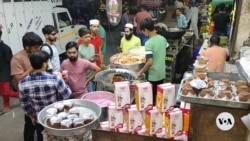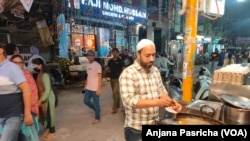A little-known Muslim neighborhood in New Delhi sprang into the spotlight in the winter of 2019-20, when thousands of women squatted along a highway for three months to protest a citizenship law, introduced by India’s Hindu nationalist government, which Muslims said discriminated against them.
Four years on, the working-class area called Shaheen Bagh has transformed from a protest site to a food hub that draws hundreds of people.
Residents link its new identity to the days when people from different parts of the city came to express solidarity with the demonstrators and often sat together in a handful of food joints on a parallel street.
“When you sit in the protest for long, you feel exhausted, and out of exhaustion you come to a tea stall to sip a cup of tea. You don’t just sip tea, you sip ideas,” said Aasif Mujtaba, one of the organizers of the protest. “It was at that time that this obscure neighborhood came to be known for the hospitality of its people and the tasty food.”
Food was never far away from the protest.
Residents cooked at home to sustain the demonstrators who sat on the highway in the bitterly cold winter late into the night. Community kitchens sprang up.
Volunteers from outside the neighborhood brought food, tea and water. Journalist Tanushree Bhasin, whose first brush with the area came during the protests, says people have been drawn back by the hospitality many experienced when locals and outsiders shared food.
“It created bonds of solidarity. A lot of people who came from different backgrounds were coming together at this protest site and food really helped them connect,” said Bhasin. “The act of feeding someone of being fed by someone always creates that bond that lasts, that affects you. Whether you are an outsider, and the protestor is offering you tea, or whether volunteers are bringing food, these are powerful connections.”
The peaceful protest on the highway dispersed when the COVID-19 pandemic shut down the city. But after restrictions were lifted, people began returning and gradually some of Delhi’s well-known Mughlai eateries set up shop to cater to the growing demand.
As the street food’s reputation spread, helped by Instagram reels and YouTube videos, the number of visitors rose, and more restaurants opened offering cuisines ranging from Mughlai to Afghan and Turkish. Now the aroma of grilled kebabs and chicken fills the air along the buzzing street.
Mohammad Nauman opened his restaurant, Changezi Chicken, in the area three months ago. “This place became famous after the protests. Delhi’s well-known food joints came here, so we also decided to open an outlet,” said Nauman as he prepared for the rush of customers on a Friday evening. He sees brisk business and says many of those who come are non-Muslims.
For locals, this food street means more than just business and jobs. They say it helps break misconceptions about Muslims in a country where critics say hate speech and discrimination targeting India’s largest minority has risen during the decade-long rule of the Hindu nationalist Bharatiya Janata Party – charges the BJP government strongly denies.
“The taboo of a bad Muslim, the taboo where Muslims are portrayed as terrorists, or the ghetto is portrayed as some unwelcoming space, this taboo is being removed by what? Food,” pointed out Mujtaba. “Even today because of these food joints large number of people from outside Delhi, especially non-Muslims, come to Shaheen Bagh and with most of them it becomes their first experience of interacting with Muslims.”
The contentious citizenship law that triggered the protests will fast-track Indian citizenship for religious minorities such as Hindus, Sikhs and Christians who faced religious persecution in Afghanistan, Bangladesh and Pakistan, but exclude Muslims. The government has dismissed criticism that the law is discriminatory.
But critics say such policies have deepened communal fissures in the Hindu-majority country where more than 200 million Muslims make up the largest minority. They point to India’s election campaign in which opposition parties accused Prime Minister Narendra Modi of making divisive comments after he said at a rally last month that the main opposition Congress Party wants to give more benefits to “those who have more children” and to “infiltrators.” The remarks were widely seen as a reference to Muslims. Modi has told interviewers on the Times Now TV channel that he is not against Islam or Muslims.
At a time when the country is polarized, the food street in Shaheen Bagh presents a dramatically different picture. Bhasin, who now has many friends in the area, has called it a “metaphor for inclusivity.”
“This is a great microcosm of collaboration, solidarity between different communities, and there is so much respect and love for each other, so definitely this is a great model for the rest of India to follow.”
But she added, Shaheen Bagh remains a politicized space.
“Even now when you come here, there is no way you eat here and don’t think about the protests. They are very inextricably linked to each other.”













